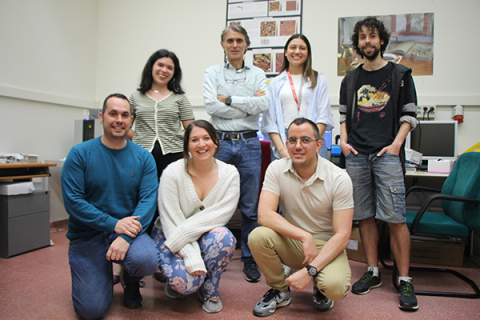The ICMM demonstrates its leadership in high-resolution force microscopy by securing three European MSCA projects in 2024

The Advanced Force Microscopy group (ForceTool), led by Ricardo García at the Institute of Materials Science of Madrid (ICMM-CSIC), is simultaneously participating in three European projects under the Marie Skłodowska-Curie Actions program, highlighting the ICMM's strength in the field of force microscopy.
"The simultaneous timing of the three projects demonstrates the ICMM's strength in the development of advanced force microscopy methods," emphasizes Ricardo García. He explains that the three projects (two started in January 2024 and one will start at the end of the year) have general objectives of improving nanoscale material characterization and training scientific personnel in this field, but each focuses on different aspects of this type of microscopy.
Thus, NanoRAM (Emerging Nanotools for Soft Matter Characterization and Manipulation) is part of the projects framed as a 'doctoral network.' It is a consortium of 19 organizations from 12 countries and involves the hiring of 14 predoctoral researchers to train them in the development and application of new nanomanipulation and characterization tools for soft matter.
Specifically, the person joining the ForceTool group will develop a high-speed nanoscale mechanical property mapping method. "The objective is to characterize in real time the processes and interactions of soft matter in its native state," says García, explaining that by 'soft matter' he refers to "a wide variety of materials ranging from polymers, biomolecules, living cells, or biological tissues."
"The results of the project will have implications for various societal challenges such as energy storage, sustainability, and health," the scientist also notes, adding that the project will involve methods of Atomic Force Microscopy (AFM), artificial intelligence, instrumentation, and material preparation.
On the other hand, LESIA (Laser Engineered Surfaces/Interfaces for Advanced Batteries) is a 'Staff Exchange' project that will develop and construct bioinspired surfaces/interfaces with electrochemical functionalities for battery components. This will be done using laser-based lithography methods and emerging nanoscale characterization techniques. "We will conduct experiments to evaluate the capabilities of the manufacturing systems and measure the functional surfaces developed using different techniques,” says García.
Finally, the group also participates in SPM 4.0 (Autonomous Scanning Probe Microscopy for Life Sciences and Medicine powered by Machine Learning), a postdoctoral collaboration project framed in the HORIZON-MSCA-2023 program in which 17 postdoctoral researchers will be hired. Specifically, the ForceTool group, as a world leader in force microscopy and nanomechanical property measurement, participates in the 'advanced SPM, machine learning for microscopy, biophysics, and data management' working group, which will develop methods for nanomechanical mapping (elastic and viscoelastic properties), nanoelectric mapping (conductive and dielectric properties), and quantitative functional SPM: from observables to physical images.
Instituto de Ciencia de Materiales de Madrid (ICMM)
Sor Juana Ines de la Cruz, 3
Cantoblanco, 28049
Madrid, España
Telephone: (+34) 91 334 90 00
Email: @email
Communication Office: @email

Acknowledge the Severo Ochoa Centres of Excellence program through Grant CEX2024-001445-S/ financiado por MICIU/AEI / 10.13039/501100011033

Contacto | Accesibilidad | Aviso legal | Política de Cookies | Protección de datos